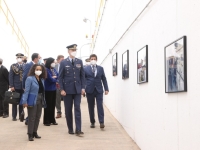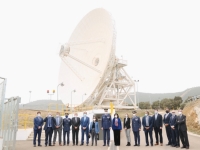Technology
A new antenna expands the capacity of the NASA complex in Madrid
Inaugurated by King Felipe VI
USPA NEWS -
King Felipe VI and the United States Ambassador to Spain, Julissa Reynoso, inaugurated this Wednesday a new antenna at NASA's Deep Space Communications Complex (MDSCC), in the Madrid town of Robledo de Chavela. Previously, Felipe VI visited the Air Force Command, Control and Telecommunications Techniques School at the Cuatro Vientos Air Base in Madrid.
The King of Spain and Ambassador Reynoso officially inaugurated the new antenna at NASA's Deep Space Network Communications Complex in Madrid, which will allow connection with spacecraft studying the solar system. It's called Deep Space Station 53, or DSS-53, and it's set to communicate with a variety of missions, including NASA's Perseverance Mars Rover.
Upon his arrival at the Complex, Felipe VI was received by the Secretary of State for Defense, Esperanza Casteleiro; the United States Ambassador to Spain, Julissa Reynoso, and the mayor of Robledo de Chavela, Fernando Casado, among other personalities. This was followed by two presentations on 'The Robledo station in the context of NASA's Royal Deep Space Communications Station', by the director of the MDSCC, and another on 'NASA's present and future missions', which was carried out by the administrator of NASA's Space Navigation and Mission Directorate.
Later, the King of Spain and Ambassador Reynoso visited the station's operations room and the antenna facilities. The new antenna, which has a 34-meter-diameter dish, began construction in 2017 at the Madrid Deep Space Communications Complex in Spain. Current antennas are limited to the frequency bands in which they can receive and transmit, thereby restricting them to communicating with specific spacecraft.
DSS-53 is the first that will be able to communicate in the entire range of communication frequencies of the Deep Space Network. This means that DSS-53 is an "all-terrain" antenna, since, in addition to being able to communicate with all DSN missions, it can also be used as support for other Madrid Complex antennas. With the addition of DSS-53 and its 34-meter twins in the three Complexes located 120 degrees longitude (Goldstone, Canberra and Madrid), the Network is preparing to guarantee the communication and navigation capacity of the missions to Mars and the Moon that are yet to come, as well as for the crew of the Artemis Missions.
The Robledo de Chavela Station (MDSCC) belongs to NASA's Deep Space Network or DSN (Deep Space Network), technically and operationally directed by the Jet Propulsion Laboratory (JPL). This Network has three Stations located equidistant from each other, about 120 degrees in longitude around the Earth. This is essential to be able to provide support 24 hours a day, 365 days a year, to the different space vehicles that can be found in any position in outer space, leaving at least one of the three stations always visible to the vehicles. This configuration allows mission controllers to communicate with spacecraft throughout the solar system at all times by counteracting Earth's rotation.
The first Station is located in Goldstone, California. Being the pioneer, it was called 'Pioneer Station' and was installed in 1958. The second station is located in Canberra (Australia) and its first antenna was installed in 1964. The third station is Robledo de Chavela, in Madrid.
Deep Space Network
The Deep Space Network is managed by the Jet Propulsion Laboratory for NASA's Space Navigation and Communications program, located at NASA Headquarters within the Human Exploration and Operations Mission Directorate. The Madrid station is managed on behalf of NASA by Spain's national research organization, the National Institute for Aerospace Technology (INTA). It is a Public Investigation Organization dependent on the Spanish Ministry of Defence. In addition to carrying out scientific research and development of systems and prototypes in its field of knowledge, it provides technological services to companies, universities and institutions.
INTA is specialized in research and technological development of a dual nature in the fields of aeronautics, space, hydrodynamics, security and defence. Its main functions include carrying out various types of tests for the verification and certification of materials, components, equipment, systems and subsystems; technical advice and provision of services to official entities and bodies, as well as to industrial or technology-based companies; and acting as a technological center of the Ministry of Defence.
More collaboration
After the inauguration of the new antenna, the United States Ambassador to Spain, Julissa Reynoso, pointed out that "it represents another important step in collaboration in the field of Spain-USA space exploration, which stands out in fundamental missions on Mars or the of the James Webb telescope.” The Robledo de Chavela complex, Ambassador Reynoso explained, “has almost 60 years of brilliant achievements; has made history in space missions, from Apollo XI, being the first to receive the mythical words of Armstrong, to the communication of the main missions today in deep space. This new antenna expands the capacity of the complex and heralds exciting new advances in space exploration,” she concluded.
Liability for this article lies with the author, who also holds the copyright. Editorial content from USPA may be quoted on other websites as long as the quote comprises no more than 5% of the entire text, is marked as such and the source is named (via hyperlink).







